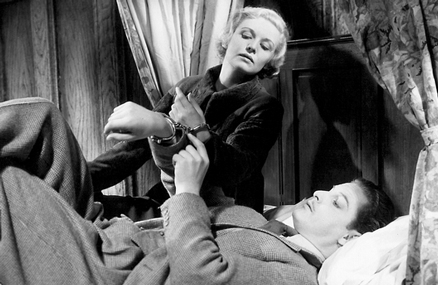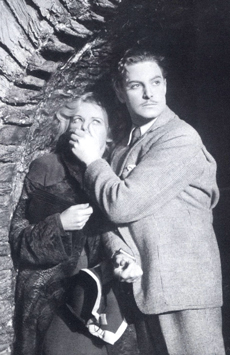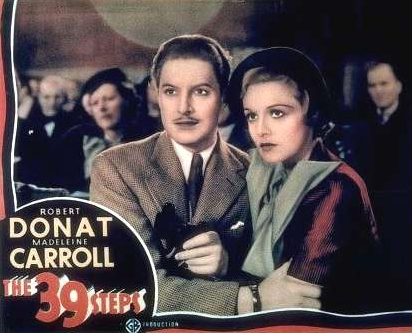
 |
|
|
|
Quick! Name five entertaining English classics from the middle 1930s not directed by Alfred Hitchcock. Although a keen search turns up some great films, even the English agree that Hitchcock holds claim to the title. And English critics of the 40s weren't necessarily biased when they said things like, "Hitchcock's best movies are the ones he made before signing with Selznick and crossing the Atlantic." Hitchcock had the London media firmly in his pocket before 1935's The 39 Steps, the picture in which he patented his ideal formula for light thriller entertainment: a spy-chase tale with a wrongly-accused man trying to clear his name. Hitchcock had over-achieved with his previous exercise in mayhem and suspense, The Man Who Knew Too Much. Even if elements of that story weren't all in balance, screenwriter Charles Bennett (and others) concocted a series of brilliantly original set-piece scenes that elicited both scares and laughs from the audience. They converge on a carefully prepared suspense sequence at the Albert Hall that, because the soundtrack is dominated by a concert in progress, makes use of expressive silent movie visuals. The tearful vision of the distressed heroine becomes a screen-filling blur, into which intrudes a close-up of an assassin's gun barrel, very much in focus. 
Practically the working recipe for unbreakable "Hitchcock" thrillers to come, The 39 Steps combines equal parts spy chase, comic sidebar scenes and sexy romantic material. The source is a book by author John Buchan, but history has awarded the credit for this saucy mix to Hitch, with a Supporting Chef nod to Bennett. Canadian visitor Richard Hannay (Robert Donat) attends a Music Hall where the amusing Mr. Memory (Wylie Watson) performs. Picked up by the exotic, enticing Annabella Smith (Lucie Mannheim), Hannay initially pays little attention to her story of being chased by spies. He changes his tune when she's knifed to death in his apartment, after giving him only one clue: Alt-na-Shellach, the name of a locale in Scotland that is essential to the safeguarding of an important military secret. Realizing that he has been framed for the murder of Annabella, Hannay flees northward on a train. He begs a beautiful fellow traveler Pamela (Madeleine Carroll) to hide him from the authorities, but she immediately turns him in. Hannay effects an escape, reaches his destination and contacts the one man who can help him uncover the nest of spies --- only to discover that this local man is the head of the entire enemy organization. Fleeing once again, Hannay finds himself handcuffed to Pamela, and forced to persuade her that his mission to thwart the spies is genuine. 
The 39 Steps even dazzled jaded New York critics and exhibitors, overturning the conviction that English films couldn't touch the exciting, high-budget adventures being turned out by Hollywood. Richard Hannay's highly entertaining race to Scotland introduced to mainstream thrillers ideas of pacing and ellipsis largely forgotten with the advent of sound. Hitchcock doesn't show everything that happens - the murder in Hannay's apartment is a complete mystery -- without pausing for scenes of a police investigation. Instead of a shot of a sunrise to show the passage of time, Hitchcock shows a cleaning woman discovering a dead body. Her scream is replaced by the shriek of a steam engine's whistle, and we leapfrog over more conventional exposition to join Hannay, his flight northward already in progress. Fritz Lang had invented the 'associative audio cut' that motivated instant transitions to otherwise random-looking new scenes. In The 39 Steps Hitchcock earned kudos for providing a stylish shock transition that 1) confirms the status of the unfortunate Annabella; 2) underscores why Hannay is running for his life; and 3) jolts the audience with the charwoman's extreme reaction, aided by the clever audio trick. The narrative has only a couple of minutes of conventional foot pursuit in the Scottish Highlands, even (as explained by one of Criterion's extras) tossing in a weak effects shot of a pursuing Autogyro, to please literal-minded readers of Buchan's book. Is the airplane a forerunner of the crop duster in North by Northwest, or the SMERSH helicopter in From Russia with Love? Hitchcock prefers to concentrate on Hannay's encounters with various locals, which enable him to poke impish fun at the notion of Scotsmen as mean-spirited and stingy. An incredibly economical visit to the house of John, a crofter (John Laurie) is often singled out for praise. John's welcome is a negotiation for payments. When he sees Hannay and his quiet wife (Peggy Ashcroft, much later a star in David Lean's A Passage to India) exchanging furtive glances he's quick to accuse them. The crisscrossed mis-readings are indicated through just a couple of quick close-ups of eyes. Hitchcock, we are told, began directing with a sketchy knowledge of sexuality from the female point of view. But by The 39 Steps he had settled on his personal fantasy female: a conservative blonde, icily reserved in public yet scandalously forward in private. He searched for this elusive creature for the rest of his filmmaking career, but succeeded in concocting elaborate fantasy versions of "her" through several gorgeous blonde actresses. Most sources agree that the first model off the assembly line was Steps' gorgeous Madeline Carroll. Her Pamela twice betrays Hannay and is his argumentative equal. They carry on a running argument, even during a midnight kidnapping. Carroll's Pamela spends a soggy night handcuffed to Hannay, out in the wild and together in the intimate confines of a country inn. Like Grace Kelly or Eva Marie Saint to Cary Grant, Carroll's scolding only looks like more teasing, as when an attempt to remove the handcuffs results in some suggestive contact between Hannay's hand and Pamela's invitingly naked leg. As for Robert Donat, the polished actor manages to be simultaneously desperate and cavalier about his plight while aiming teasing insults at Pamela. She doesn't know whether to bash him in the head while he sleeps, or leap recklessly into his arms. The couple is aided and abetted by a sympathetic innkeeper's wife (Hilda Trevelyan), whose protective attitude to lovers on the run always elicits applause from screening audiences. 
The story finishes with a clever twist that sends one out admiring The 39 Steps for its fine-tuned pacing and narrative symmetry. And Hitchcock made certain that his personal stamp of humor would be remembered first, even before the engaging performances of his lead actors. From this point forward the "Master of Suspense" would keep his audiences guessing what the next trick up his sleeve would be. The Criterion Collection's Blu-ray of The 39 Steps is a very good restoration of Alfred Hitchcock's long-confirmed classic thriller. The transfer is quite good, although we suspect that the best original elements are long gone; Criterion lists the digital tools used to spiff up their presentation but does not specify the actual source. The film shows some wear yet is the best looking and sounding copy of the show I've ever seen. Much more of the dialogue - all that chatter in the Music Hall! -- is now clearly audible. Disc producers Susan Arosteguy and Karen Stetler faced up to the challenge of finding "new" extras for a film that has been analyzed and raked over since the beginning of pop film criticism and the Truffaut/Hitchcock book. We're given a commentary by Hitchcock specialist Marian Keane, an English TV docu on the director's pre-war career; an excerpt from a 1966 Hitchcock TV interview and an entertaining visual essay conducted by Hitchcock scholar Leonard Leff. From the vault comes a 1937 radio adaptation starring Ida Lupino and Robert Montgomery, audio excerpts from François Truffaut's 1962 Hitchcock interviews and a gallery of original designs. Bringing out the film's Scottish flavor is critic/filmmaker David Cairns' insightful liner note essay. Cairns neatly disposes of the MacGuffin issue and then just as persuasively sketches the similarity of Hitchcock's disconnected, often unexplained thriller plotting to a surreal nightmare. The quote, "I make nightmares", isn't restricted to the director's more frightening films.
On a scale of Excellent, Good, Fair, and Poor,
The 39 Steps Blu-ray rates:
Reviews on the Savant main site have additional credits information and are often updated and annotated with reader input and graphics. Also, don't forget the 2011 Savant Wish List. T'was Ever Thus.
Review Staff | About DVD Talk | Newsletter Subscribe | Join DVD Talk Forum |
| ||||||||||||||||||